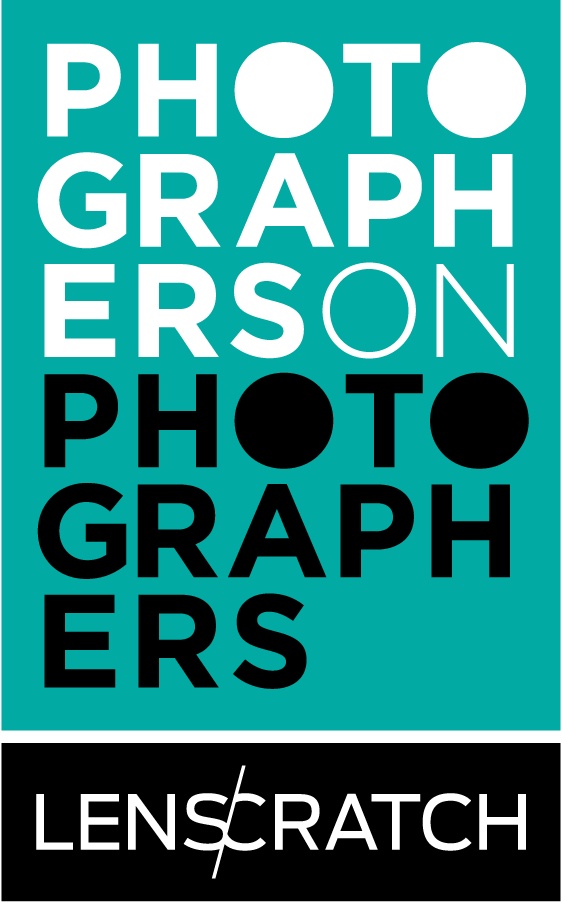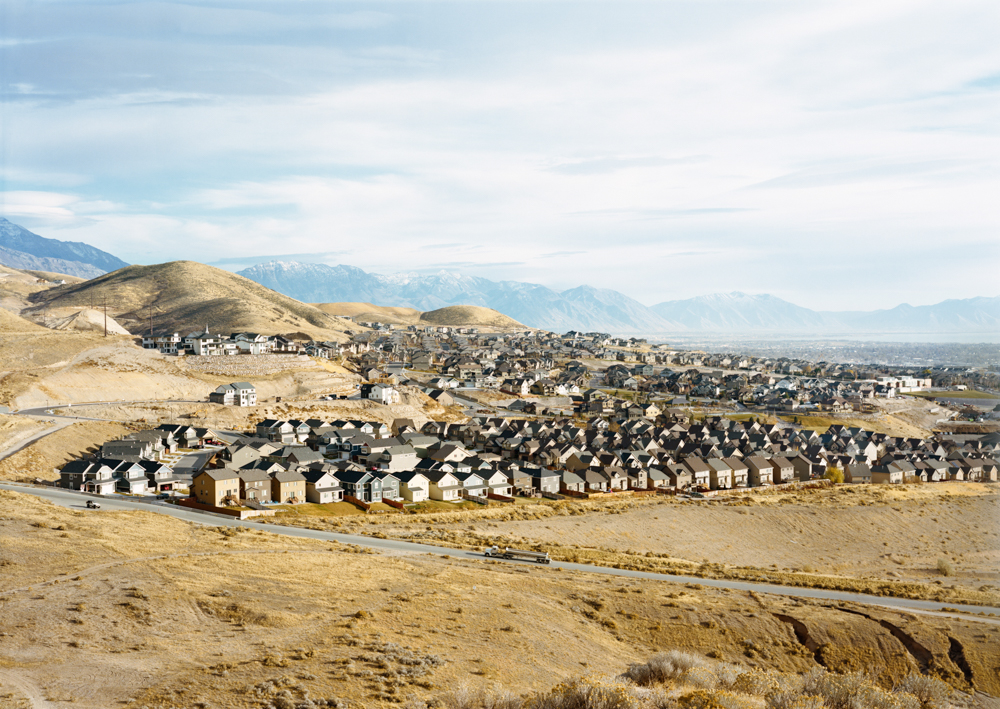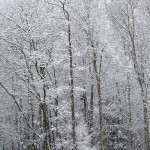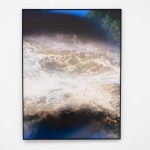Photographers on Photographers: Emily Wall in Conversation with Victoria Sambunaris
I first saw Victoria Sambunaris’ work at the Museum of Art at Brigham Young University during my last semester as a student. I was struck by the scale of the prints as well as how the strong geometry within the work carried her themes. I was further impressed when she spoke to one of my classes; her work reflected her words and her words reflected her work. I have spent the last few years trying to find bodies of work from other artists that weave narrative and photography so strongly, and have tried to emulate this in my own work.

©Victoria Sambunaris, Untitled, (white trains on salt flats, I-80), Great Salt Lake Desert, Utah, 2002, Chromogenic print
Based in New York, Victoria Sambunaris structures her life around a photographic journey traversing the American landscape for several months per year. Equipped with a 5×7 inch field camera, film, a video camera and research material, she crosses the country alone tenting on top of her car. Her large-scale project based photographs document the continuing transformation of the American landscape with specific attention given to expanding political, technological and industrial interventions.
Sambunaris received her MFA from Yale University in 1999. Her work has been widely exhibited in museums and galleries throughout the United States and abroad. She is the recipient of numerous awards including the 2021 John Simon Guggenheim Memorial Foundation Fellowship, the Julius Shulman Excellence in Photography Award, the Aaron Siskind Foundation Individual Photographer’s Fellowship and the Anonymous Was a Woman Award. In 2011 a twelve-year survey of her work was exhibited at the Albright-Knox Art Gallery in Buffalo, NY and travelled throughout the US. Her work is held in numerous collections including the Museum of Modern Art, the Whitney Museum of American Art, the Albright-Knox Art Gallery, the Lannan Foundation, the San Francisco Museum of Modern Art and the National Gallery of Art. In 2019, Sambunaris was commissioned by the Dia Art Foundation to photograph Robert Smithson’s Spiral Jetty for the 50 th anniversary and Sun Tunnels by Nancy Holt. Radius Books Published her first monograph Taxonomy of a Landscape. She is represented by Yancey Richardson Gallery in NY.
Follow Victoria Sambunaris on Instagram: @victoriasambunaris

©Victoria Sambunaris, Untitled, (Alaskan pipeline at Atigun Pass), Brooks Range, Alaska, 2003, Chromogenic print
Emily Wall: What drew you to photography initially? What keeps you excited about photography? How did landscape photography become your niche?
Victoria Sambunaris: My father’s interest in photography surely influenced me. He had a Super 8 movie camera with a projector and screen and he bought the first Polaroid SX70, the sexy one that was leather and chrome, folded flat and slipped into a leather case. At the time, it was an expensive investment and remember it being a precious object in our household. Life Magazine was kicking around back then with big color photos inducing wanderlust at a young age. And in 7th grade, I took a black and white photography class and saved to buy my first camera, a Nikon FM. As a young, insecure, awkward kid, photography was an obvious vehicle for me to approach the world and hide behind the camera.
There’s something about spending time observing what we’ve done to the landscape that triggers wonder. And that’s the key component of what I do: curiosity. And it’s what keeps me excited about photography.
As far as landscape photography, I grew up in Lancaster, Pennsylvania an industrial manufacturing town surrounded by huge expanses of agricultural land. As a child, on the weekends, we’d drive out to the country from our home in the city for hours just to look at the landscape. The Amish or as they are called, the Pennsylvania Dutch inhabited much of the lands around Lancaster. The Amish live a plain and simple life in their clothes and habit rejecting modern conveniences such as automobiles, electricity, telephones and even being photographed. We would circulate around their pastoral lands where they worked plowing the lush dark fields with horses and mules as though in the 19th century.
Over the years of traveling back to Lancaster as a young adult, I noticed more and more development and changes taking place on the landscape–those pristine farming landscapes were being overrun by malls, corporate offices and housing developments. I noticed this type of development throughout various regions of the country. And a homogeneity was starting to spread like a disease. Simultaneously, what were once thriving industrial towns were now in a state of dystopia. This became the locus of my work. After graduate school in 1999, I began to travel west across the US The more I saw, the more I wanted to know about what I was seeing. While on the road, I was inquisitive and began to speak to everyone I encountered, asking about their communities, the industry, visiting historical societies to understand the history of place, researching geology to understand the physicality of land and discovering how these towns evolved around resources and transportation systems. Tying back to my early experiences that you asked about, my family wasn’t so verbal, but those early childhood moments of just looking continues in my daily life and the land’s current status has seeped into everything I do.
EW: Is it hard to keep yourself motivated during your long photographic trips? How do you pick your destinations? How do you fund these trips?
VS: There’s nothing really comfortable about what I do. Being on the road alone as a woman for 22 years draws a lot of questions especially at campsites surrounded by people grilling hot dogs with their families. But a conversation always ensues that keeps me enthralled. There may be days on end that I don’t speak to anyone but there’s always something engaging or remarkable about what I am seeing. And this keeps me motivated.
I may read an article in the newspaper, read a book or partake in a conversation that inspires a trip. Every year since 2000, I have traveled alone by car somewhere across the country and remained as long as possible. Some of the projects take years to complete and most of them lead me to the next area of interest.
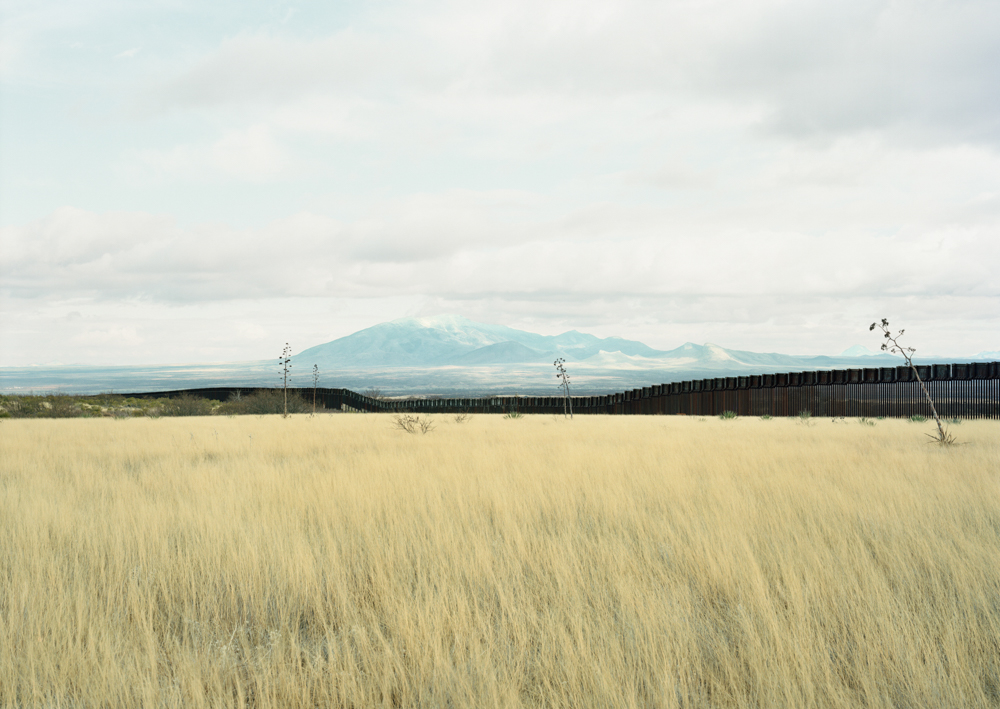
©Victoria Sambunaris, Untitled, (border view south from grasslands), Hereford, Arizon, 2010, Chromogenic print
Initially, I taught during the year and was only able to get on the road to work in the summers. This inhibited the work and eventually realized I needed more flexibility to remain on the road. I began to pick up editorial work to help fund the trips, credit cards, loans, whatever it would take. Later came grants and sales. I live a minimal existence and I have chosen not to live a more conventional life with a family and such. My responsibility is to myself and the work. While traveling, I’m camping, living modestly and in the moment. This type of existence in contrast to my energetic life in New York creates balance and keeps life diverse.
EW: By photographing landscape over a long period of time it seems like themes of climate change naturally emerge, do you see this playing a big part in your work?
VS: My work surely relates to the many consequential topics surrounding climate change today: massive mining operations, native fossil fuel, burgeoning fractal energy infrastructure, transportation systems, and consumerism. These are topics I have been addressing in my work since my graduate school days. My interest was always deeply personal. My parents immigrated to America from Greece in search of the “American Dream.” They hoped that their children would have a better life than their own working class existence. I began by questioning the mythic American ideals of equality, independence and freedom that is so much a part of our national political rhetoric and cultural imagery.

©Victoria Sambunaris, Untitled, (Oil/chemical tanker, Overseas Tampa, USA), Houston Ship Channel, Texas, 2015, Chromogenic print, 27×40 inches
To tie it back in to your question, my intent has not been to address climate change per se but to question our use of landscape and to understand the consequences of the decisions we make in the name of capitalism. It is my personal quest. I don’t make this work in order to preach. And I’m not a documentary photographer per se. Instead, I’ve spent these many years fulfilling something in myself: a need to understand the complexity of landscape and more recently of how ideas about landscape have evolved to contribute to a polarized national political state.

©Victoria Sambunaris, Untitled, (train crossing Great Salt Lake), Near Promontory, Utah, 2016, Chromogenic print
EW: How has your creative process evolved? Are there things you did initially that you’ve maybe stopped doing or things you’ve picked up along the way that you wish you had started doing earlier?
VS: Not much has changed in my process, I’m a creature of habit. I continue to work with a large format view camera and color negative film. I recently started to throw some sheets of black and white film in the back of the camera and only regret I did not do this earlier when I first started. I collect ephemera from my trips, journal my experiences, snapshot everything around me and shoot video on occasion. I only wish I had done more of everything.
EW: Where do you go outside of photography for inspiration? Is there a specific photograph you’ve made that stands out, that draws you back?
VS: There is no shortage of places to find inspiration. A few years ago, I discovered the art of the archive. I had applied for a fellowship at the Charles Redd Center for Western Studies at Brigham Young University in Provo, Utah. After receiving the fellowship, I relocated to Provo and immersed myself in the L. Tom Perry Special Collections Library which contains a major trove of Western holdings. The end result was an exhibition I curated of my findings from the collection. Among many findings, I discovered obvious figures such as William Henry Jackson’s work and journals during the Hayden Expedition. In his writings, he describes his time in Utah camped at Echo Canyon with details about his disappointments, stollen horses and his steak and potato dinner. I discovered the works of regional photographers like Charles Savage and George Anderson, obscure pioneer journals describing an uninhabited wilderness and finally a stack of black and white 5×7 photographs of every home in a mining town about to be demolished. The photographs were reminiscent of a New Topographics installation but much earlier. I discovered working methods of earlier artists, the way they perceived the world, their intimacies and their alternate or unconscious views of place. The experience inspired my next trip in 2017 of Utah and a new body of work that was shown at Yancey Richardson Gallery in 2019 and at Brigham Young University Museum of Art in 2020.
EW: What are you working on at the moment? What’s next?
VS: I just completed a new body of work in the deserts of California made throughout the two years of lock down. Since my return east in December, I’ve been in the darkroom printing and editing the new work and wondering if I’m heading back to California or starting something new.

©Victoria Sambunaris, Untitled, (Dune buggy), All American Canal, near Yuma, California, 2021, Chromogenic print
EW: Do you have any wisdom or advice for photographers just starting out?
VS: My advice to photographers starting out is stay true to yourself and don’t follow trends.
Emily Wall holds a BFA in photography from Brigham Young University. In 2020, during her last semester, she was an intern for Lenscratch and has been helping out ever since. The foundation of her work is her family and environment. She grew up in a large, religious family and was drawn to photography for its ability to dismantle and dissect relationships. Her current work delves into the landscape of childhood and the religious narrative of her youth. Emily’s work has been published in Exponent ii and Fotofilimic, and has been shown in group exhibitions at Center Gallery NYC, Box13 Artspace, and Springville Museum of Art. Currently she resides in Upstate New York where she pursues her own practice.
Follow Emily Wall on Instagram: @emilyannwall
Posts on Lenscratch may not be reproduced without the permission of the Lenscratch staff and the photographer.
Recommended
-
Time Travelers: Photographs from the Gayle Greenhill Collection at MOMADecember 28th, 2025
-
Marcia Molnar: The Silence of WinterDecember 24th, 2025
-
Paccarik Orue: El MuquiDecember 9th, 2025
-
Jackie Mulder: Thought TrailsNovember 18th, 2025
-
Interview with Maja Daniels: Gertrud, Natural Phenomena, and Alternative TimelinesNovember 16th, 2025


